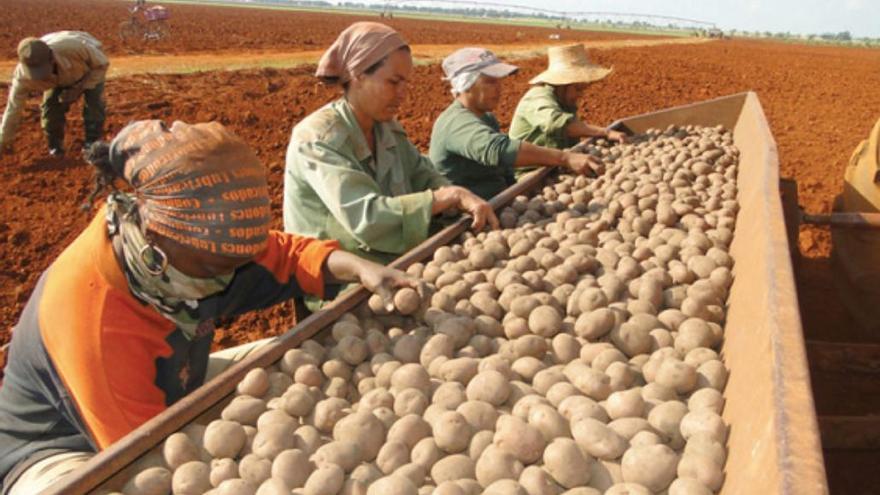
![]() 14ymedio, Havana, September 30, 2023 — Of the 994,000 Cubans registered as workers of the Ministry of Agriculture, only 60% are directly linked to production. That number – barely 596,400 farmers – is symptomatic: very few want to work in the island’s fields, marked by the lack of inputs, insecurity and crime.
14ymedio, Havana, September 30, 2023 — Of the 994,000 Cubans registered as workers of the Ministry of Agriculture, only 60% are directly linked to production. That number – barely 596,400 farmers – is symptomatic: very few want to work in the island’s fields, marked by the lack of inputs, insecurity and crime.
“Are we running out of workers in the fields?” asked an analysis in the official magazine Cubahora – responding to a broadcast of the official program Cuadrando la Caja [Squaring the Box]. The answer, after the alarming number of active farmers offered by the ministry’s personnel director, Adriana Ballester, is affirmative.
The problem, the official explained, is also sociological. The majority of residents in rural areas – 23% of the Island’s population, about 2.3 million people – tend to move to cities and towns. Internal migration, which is carried out precariously and in the midst of “serious economic and social difficulties” – direclty effects the availability of labor in the fields and is the reason why in Cuba we cannot speak of “food security and sovereignty.”
Those who work directly with the land – “cooperativists, usufructuaries* and tenants” – do so, according to the official, counting on “family support,” and this labor does not appear in the ministry’s figures. However, he clarified, the outlook is not so dark and there are “motivations to remain in the countryside, especially among those young people descended from predominantly rural families, with an interest in working the land.”
Those who work directly with the land — “cooperativists, usufructuaries and tenants” -– do so counting on “family support”, which does not appear in the ministry’s figures
That the countryside is losing population – while the cities become increasingly overcrowded – is a pressing problem for Juan Carlos Alfonso, deputy head of the National Office of Statistics and Information (Onei). According to the manager, the share of Cubans who live in cities – currently 56% – will continue to grow compared to those who live in towns and rural areas.
Most of the Cubans who leave the countryside, he adds, are women of active and reproductive age. The danger, Alfonso says, is that “the permanence of women in the countryside is vital” so that “families” continue to emerge that, over time, will provide workers to the agricultural sector.
However, the situation is not the same in all provinces. While Havana is, “by definition,” a totally urban area, in several eastern provinces, such as Granma, 40% of the population lives in the countryside and mountains. It also coincides that the eastern rural areas are the ones with the greatest male presence and the ones that age the fastest, according to Onei.
These characteristics have generated a “situation” that Alfonso did not dare to describe with any adjective.
Why do rural residents emigrate? After a long reflection on how little blame should be attributed to the State in these phenomena, which does not cease “monitoring” the agricultural issue, María Ofelia Rodríguez – from the Center for Demographic Studies of the University of Havana – admitted that there is a problem with salary “incentives” and that the farmers are not paid according to their results. In addition, there are difficulties with marketing, not to mention transportation, “road problems,” fuel for cooking food in remote environments, among others.
Most residents in the areas rural areas – 23% of the Island’s population, about 2.3 million people – tend to move to cities and towns
Rodríguez said she was also concerned about another side of the problem: the fact that “gender relations” are “asymmetrical” between farmers and their wives, which “affects this mostly female migration to urban areas.”
It is also difficult to access Health and Education services in the fields. Hence, many families “feel the need to bring their children nearer to schools, to get closer to hospitals, which are mainly concentrated in areas that are not the classic rural settlements.”
None of the experts who appeared on Cuadrando la Caja alluded to an additional problem: the insecurity of rural areas, theft of livestock and banditry, which has motivated the farmers themselves – in the face of the inaction of the Police – to organize shifts of guard and “parties” to patrol the properties.
In Granma, several farmers interviewed by 14ymedio are clear that, if they do not protect their farms against rustlers, no one will do it for them. The measure they have taken will not be ideal, they believe, but it is the most effective: “We are arming ourselves.”
*Translator’s note: Usufruct, a form of leasing, is defined in Wikipedia as follows: “Generally, a usufruct is a system in which a person or group of persons uses the real property (often land) of another. The “usufructuary” does not own the property, but does have an interest in it, which is sanctioned or contractually allowed by the owner.” Articles in Translating Cuba that address usufruct.
____________
COLLABORATE WITH OUR WORK: The 14ymedio team is committed to practicing serious journalism that reflects Cuba’s reality in all its depth. Thank you for joining us on this long journey. We invite you to continue supporting us by becoming a member of 14ymedio now. Together we can continue transforming journalism in Cuba.
